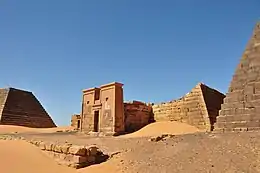Pyramids of Meroë
The Pyramids of Meroë are part of the larger group of Nubian pyramids, built at the time of the Kushite Kingdom over a period close to a millennium. Near Meroë, three royal cemeteries were constructed:[1]
- South Cemetery features nine royal pyramids. Four of the pyramids belonged to Kings and five belonged to queens. One hundred and ninety-five other tombs complete the cemetery.
- North cemetery contains forty-one royal pyramids. Thirty belonged to kings, six to queens and five to other royals. The cemetery has three more non-royal tombs for a total of forty-four.
- West cemetery is a non-royal site. It contains some one hundred and thirteen tombs.[2]
.jpg.webp) Pyramids of Meroë | |
 Pyramids of Meroë Shown within Northeast Africa  Pyramids of Meroë Pyramids of Meroë (Sudan) | |
| Location | Northern State, Sudan |
|---|---|
| Region | Nubia |
| Coordinates | 16°56′18″N 33°44′57″E |
| Type | Settlement |
| History | |
| Cultures | Nubians |
| Site notes | |
| Condition | restored |
On 8 September 2020, the pyramids were threatened for the first time by floods.
Southern Cemetery at Begarawiyah
The southern cemetery is the burial place of the Meroitic side of the royal family from ca 720 – 300 BCE. Towards the end the cemetery became the main royal burial site for the Kings of Meroë.[3] This cemetery contains several pyramids:[2]
- Beg.S 1 – Queen's pyramid (anonymous)
- Beg.S 2 – Queen's pyramid (anonymous)
- Beg.S 3 – Queen's pyramid (anonymous)
- Beg.S 4 – King's sister, King's Mother, Kenreth = Saleran? (or Saluwa?).
- Beg.S 5 – King Amanislo
- Beg.S 6 – King Arqamani or King Khnum-ib-re(?)
- Beg.S 9 – Queen's pyramid (anonymous)
- Beg.S 10 – King Kalka Kaltaly
- Beg.S 20 – Prince Weteriken (?), son of Amaniastabarqa or Siaspiqa[4]
- Beg.S 85 – Princess Mernua, contemp. King Anlamani – Aspelta[4]
- Beg.S 500 – Prince Kariben, son of King Siaspiqa or King Nasakhma[4]
- Beg.S 503 – Queen Khennuwa, approximately time of Nastasen[3]
 The Southern Cemetery of Meroë
The Southern Cemetery of Meroë.JPG.webp)
North Cemetery at Begarawiyah
After the southern cemetery was full, the burials continued in the north. This site contains the royal burials of the Kings and Queens of Meroë from ca 300 BCE to about 350 CE.[3] The northern cemetery contains many royal pyramids:[2]



- Beg. N1 – Queen Amanitore[5]
- Beg. N2 – King Amanikhabale[3][5]
- Beg. N3 – Queen's Pyramid (unidentified)
- Beg. N4 – King Amantekha[5]
- Beg. N5 – Prince Arikhankharer,[5] son of Amanitore
- Beg. N6 – Queen Amanishakheto[5]
- Beg. N7 – King Arqamani[5] (Merqetek)
- Beg. N8 – Nahirqa(?) (Nayakhensan-mery-Isis ?).
- Beg. N9 – King Tabirqo[5] (= Adikhalamani ?)[5]
- Beg. N10 – King Shorkaror or Arikhankharer
- Beg. N11 – Queen Shanakdakhete[5]
- Beg. N12 – King's Pyramid (unidentified)[5]
- Beg. N13 – King Naqyrjinsan[6][5]
- Beg. N14 – King Teriteqas[5]
- Beg. N15 – King Pisakar[7]
- Beg. N16 – King Amanitaraqide[7]
- Beg. N17 – King Amanitenmemide,[7] Nebmaatre I
- Beg. N18 – Queen Amanikhatashan[7]
- Beg. N19 – King Tarekeniwal[7]
- Beg. N20 – King Tanyidamani[5]
- Beg. N21 – Queen Amanirenas[5]
- Beg. N22 – King Natakamani[5]
- Beg. N24 – King Yesbokheamani[7]
- Beg. N25 – Queen's Pyramid (unidentified)[7]
- Beg. N26 – Queen's Pyramid (unidentified)[7]
- Beg. N27 – King Maleqorobar[7]
- Beg. N28 – King Teqorideamani[7]
- Beg. N29 – King Takideamani[7]
- Beg. N30 – King Aritenyesbokhe[7]
- Beg. N32 – King Amanikhalika[7]
- Beg. N34 – King Tamelerdeamani[7]
- Beg. N35 – Maniterara(ze), Teraramani.
- Beg. N36 – King Aryesbokhe[7]
- Beg. N37 – King Amanikhareqerem[7]
- Beg. N38 – King Teritedakhatey[7]
- Beg. N40 – King Teritnide[7]
- Beg. N41 – King Adeqetali[7]
- Beg. N51 – King's Pyramid (unidentified)[7]
- Beg. N52 – Unknown
- Beg. N53 – King Arnekhamani[5]
- Beg. N55 – Unknown
- Beg. N56 – Prince Arikakahtani,[5] son of Amanitore
Treasures and artifacts of the North Cemetery
Numerous treasures were discovered in the pyramids since the 19th century.
 Lamp with handle in the shape of a horse, from the pyramid of Queen Amanikhatashan in Meroë (c.62-c.85 CE). Museum of Fine Arts, Boston
Lamp with handle in the shape of a horse, from the pyramid of Queen Amanikhatashan in Meroë (c.62-c.85 CE). Museum of Fine Arts, Boston Usekh collar of queen Amanishakheto
Usekh collar of queen Amanishakheto Bracelet from the tomb of Amanishakheto
Bracelet from the tomb of Amanishakheto._Pyramidengruppe_A._Pyr._15._Gold-_und_Silber-_Schmuck_aufgefunden_von_Ferlini_1830._(_jetzt_im_K._Museum_zu_Berlin.)_(NYPL_b14291191-44190).tiff.jpg.webp) Some of the treasures found by Ferlini in the pyramid of queen Amanishakheto
Some of the treasures found by Ferlini in the pyramid of queen Amanishakheto Wall of the Pyramid chapel of Amanitenmemide
Wall of the Pyramid chapel of Amanitenmemide Detail of Pyramid Chapel Beg. N1
Detail of Pyramid Chapel Beg. N1
West Cemetery at Begarawiyah

- Beg. W14 – Nasapanasap
- Beg. W18 – Taktidamani
- Beg. W19 – Tedeqen
- Beg. W105 – Amanipilde
- Beg. W113 – King Mashadeakhel
- Beg. W342 – Atedekey
References
- Dows Dunham (ed.); The Royal Cemeteries of Kush, volume V; 1963.
- G. A. Reisner, The Meroitic Kingdom of Ethiopia: A Chronological Outline, The Journal of Egyptian Archaeology, Vol. 9, No. 1/2 (Apr., 1923), pp. 34–77
- George A. Reisner, The Pyramids of Meroë and the Candaces of Ethiopia, Museum of Fine Arts Bulletin, Vol. 21, No. 124 (Apr., 1923), pp. 11–27
- Dows Dunham and M. F. Laming Macadam, Names and Relationships of the Royal Family of Napata, The Journal of Egyptian Archaeology, Vol. 35 (Dec., 1949), pp. 139–149
- Welsby, Derek A. (1998). The Kingdom of Kush: The Napatan and Meroitic Empires. Princeton: Markus Weiner Publishers. p. 208. ISBN 1-55876-182-9.
- Fontes Historiae Nubiorum II, p.686
- Welsby, Derek A. (1998). The Kingdom of Kush: The Napatan and Meroitic Empires. Princeton: Markus Weiner Publishers. p. 209. ISBN 1-55876-182-9.

